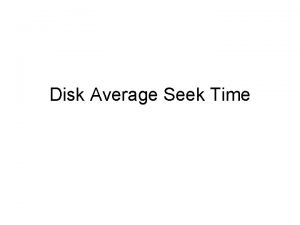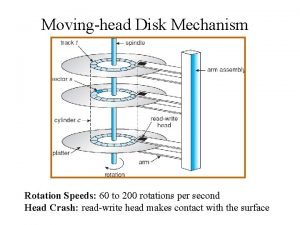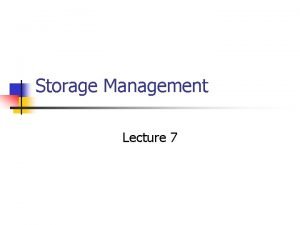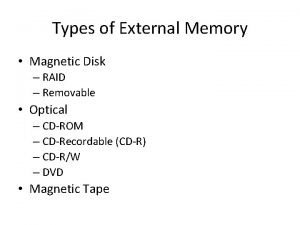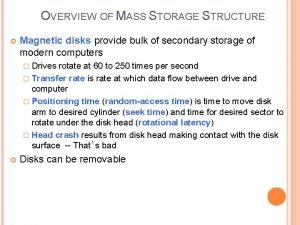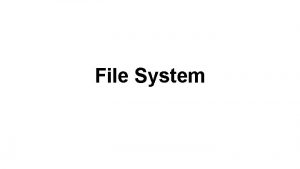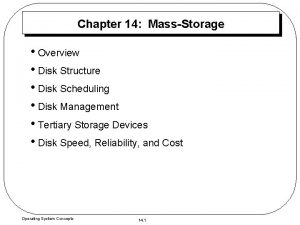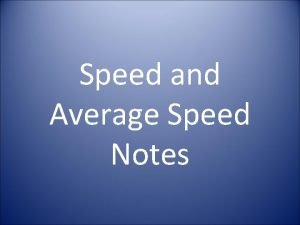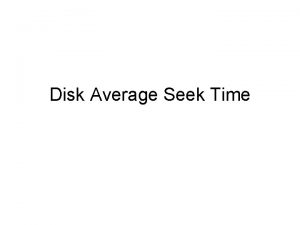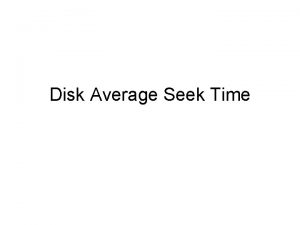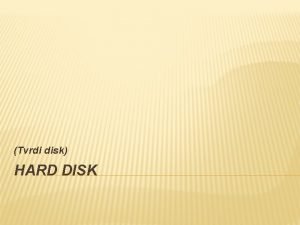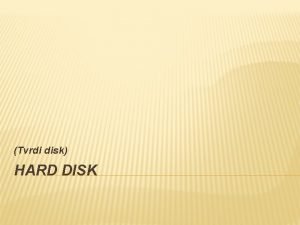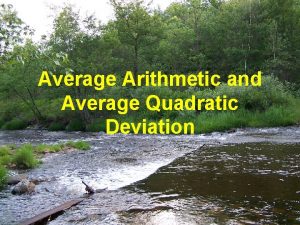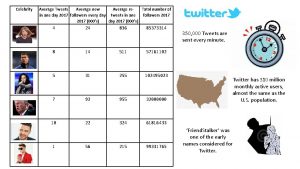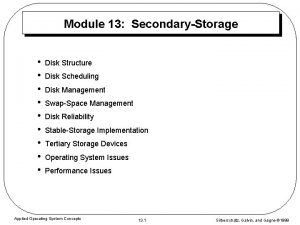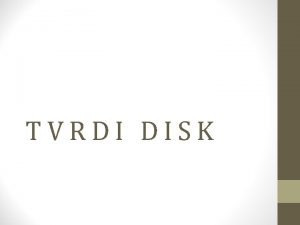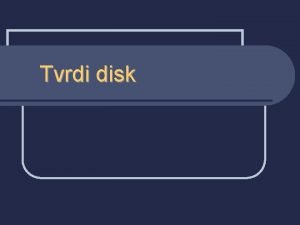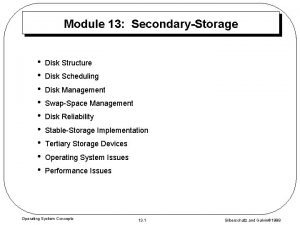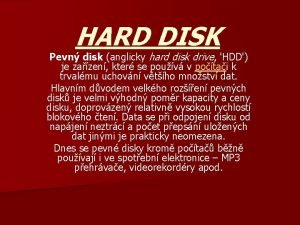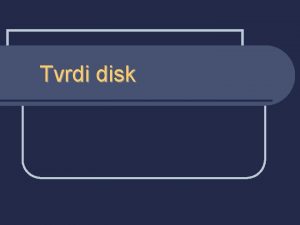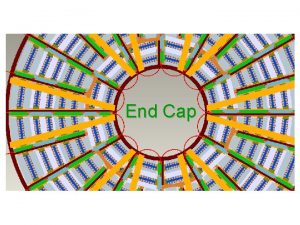Disk Average Seek Time Multiplatter Disk readwrite head




















- Slides: 20

Disk Average Seek Time

Multi-platter Disk read/write head read/write arm Disk platter

Multi-platter Disk track cylinder sector

Seek Time measures the amount of time required for the read/write heads to move between tracks over the surface of the platters 0. 0 ms platter Average Seek Time = 0. 8 ms

Rotational delay After the read/write arm has picked the right track, the time it takes for the requested sector (on that track) to come under the read/write head 0. 0 ms 0. 2 ms read/write arm platter

Other measurements Avg. seek time = Avg. Rotation latency / rotational delay = latency halfway around the disk Transfer time = the time it takes to transfer a block of bits, typically a sector, under the read/write head - Function of the size, rotational speed, recording density of a track, speed of electronics connecting disk to computer Controller Overhead time = the overhead the controller imposes in performing I/O access

Example taken from: Computer architecture by J. Hennessy and D. Patterson What is avg. time to read or write (access time) a 512 -byte sector for a typical disk? Avg. seek time (ST) = 5 ms Transfer time (TT) = 40 MB/sec Rotational delay (RD) = 10, 000 RPM Controller overhead (CO) = 0. 1 ms Assume the disk is idle and so no queuing delay dat = ST + RD + TT + CO = 5 ms + (0. 5/10, 000 rpm) + (0. 5 KB/40. 0 MB/sec) + 0. 1 ms = 5. 0 + 3. 0 +0. 013 + 0. 1 = 8. 11 ms Assuming the measured seek time is 33% of the calculated average. So we obtain: dat = 1. 67 ms + 3. 0 ms + 0. 013 ms + 0. 1 ms = 4. 783 ms Note that 0. 013/4. 783 = 0. 3% is the disk transferring data in this example

Disk Scheduling

Disk Scheduling Access Time: seek time + rotational delay + transfer time + controller overhead Transfer Time: time to copy the block to and from the disk Disk Bandwidth: total number of bytes transferred, divided by the total time between the first request for service and the completion of the last transfer Seek Time: the for the disk arm to move the heads to the cylinder containing the desired sector. Rotational Delay: time waiting for the disk to rotate the desired sector to the disk head

Disk Scheduling Disk Head Scheduler: After the completion of the current operation, the disk head scheduler examines the current contents of the queue and decides which request to be served next. The Disk Head Scheduler must consider 3 important factors 1. overall performance of the disk 2. fairness in treating processes 3. cost of executing scheduling algorithm Scheduling Algorithms First-In/First-Out (FIFO) Shortest Seek Time First (SSTF) Scan or Elevator Look

Disk Scheduling First-In/First-Out FIFO Head at 53 0 14 98 183 37 122 14 124 65 37 53 65 67 98 122 124 67 183 199 45 45 85 146 + + 146 85 + 108 110 59 2 85 + 110 + 59 + 2 = 640

Disk Scheduling Shortest Seek Time First - SSTF Head at 53 0 14 98 183 37 122 14 124 65 37 53 65 67 98 67 122 124 183 199 12 12 2 30 23 84 24 2 59 + 2 + 30 + 23 + 84 + 2 + 59 = 236

Disk Scheduling Scan Head at 53 0 14 98 183 37 122 14 124 65 37 53 65 67 98 67 122 124 183 199 16 16 23 14 65 2 31 24 2 59 + 23 + 14 + 65 + 2 + 31 + 24 + 2 + 59 = 236

Disk Scheduling Look Head at 53 0 14 98 183 37 122 14 124 65 37 53 65 67 98 67 122 124 183 199 16 16 23 51 2 31 24 2 59 + 23 + 51 + 2 + 31 + 24 + 2 + 59 = 208

Disk & Sector Scheduling s 1 s 3 First-In/First-Out FIFO s 2 Head at 53 0 14 98 183 37 122 14 124 65 37 53 65 67 98 122 124 67 183 199 45 45

Disk & Sector Scheduling s 1 s 2 First-In/First-Out FIFO s 3 Head at 53 0 14 98 183 37 122 14 124 65 37 53 65 67 98 122 124 67 183 199 45 45

Disk & Sector Scheduling s 2 First-In/First-Out FIFO s 3 Head at 53 0 14 98 183 37 122 14 124 65 37 53 65 67 98 122 124 67 183 199 45 45

Disk & Sector Scheduling First-In/First-Out FIFO s 3 Head at 53 0 14 98 183 37 122 14 124 65 37 53 65 67 98 122 124 67 183 199 45 45

Disk & Sector Scheduling First-In/First-Out FIFO Head at 53 0 14 98 183 37 122 14 124 65 37 53 65 67 98 122 124 67 183 199 45 45

Disk & Sector Scheduling First-In/First-Out FIFO Head at 53 0 14 98 183 37 122 14 124 65 37 53 65 67 98 122 124 67 183 199 45 45 85 146 + + 146 85 + 108 110 59 2 85 + 110 + 59 + 2 = 640
 What is a disk seek
What is a disk seek Readwrite web
Readwrite web We seek him here we seek him there
We seek him here we seek him there Moving head disk mechanism in os
Moving head disk mechanism in os The head of moving head disk with 100 tracks
The head of moving head disk with 100 tracks Difference between speed and velocity class 9
Difference between speed and velocity class 9 Types of storage management
Types of storage management Types of magnetic disks
Types of magnetic disks Moving head disk mechanism
Moving head disk mechanism Moving head disk mechanism
Moving head disk mechanism Disk structure in operating system
Disk structure in operating system Simple indexing
Simple indexing The attacking firm goes head-to-head with its competitor.
The attacking firm goes head-to-head with its competitor. Html teksta noformēšana
Html teksta noformēšana Parts of the neck
Parts of the neck What is tonic syllable
What is tonic syllable Pro minent
Pro minent Long head short head bicep
Long head short head bicep Pre-head head tonic syllable tail
Pre-head head tonic syllable tail Example of elapsed time
Example of elapsed time Average 400 meter time
Average 400 meter time
